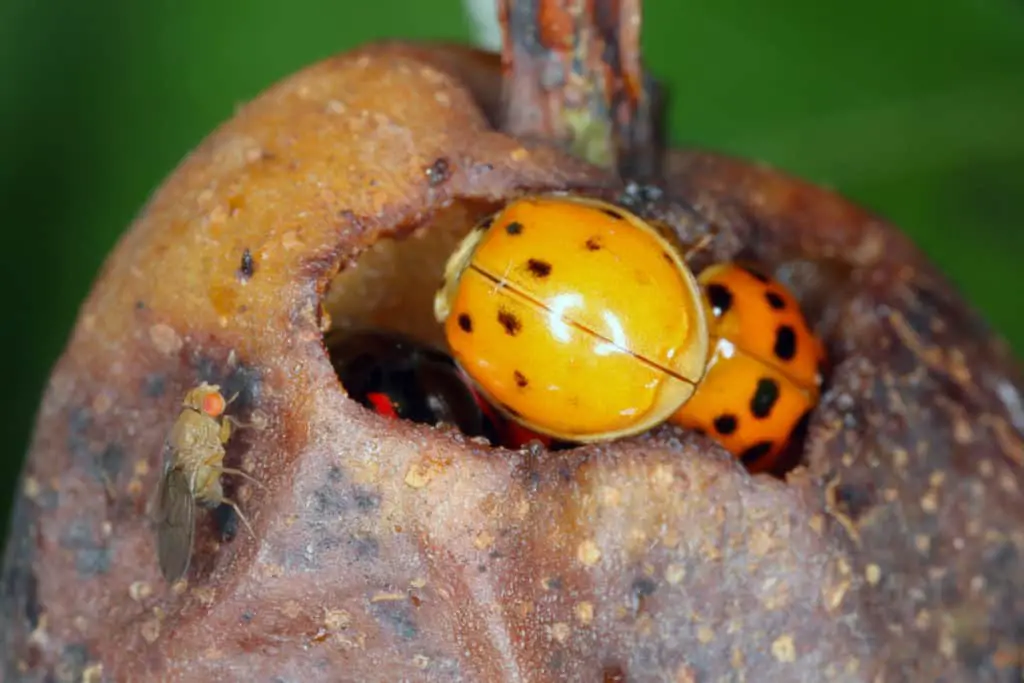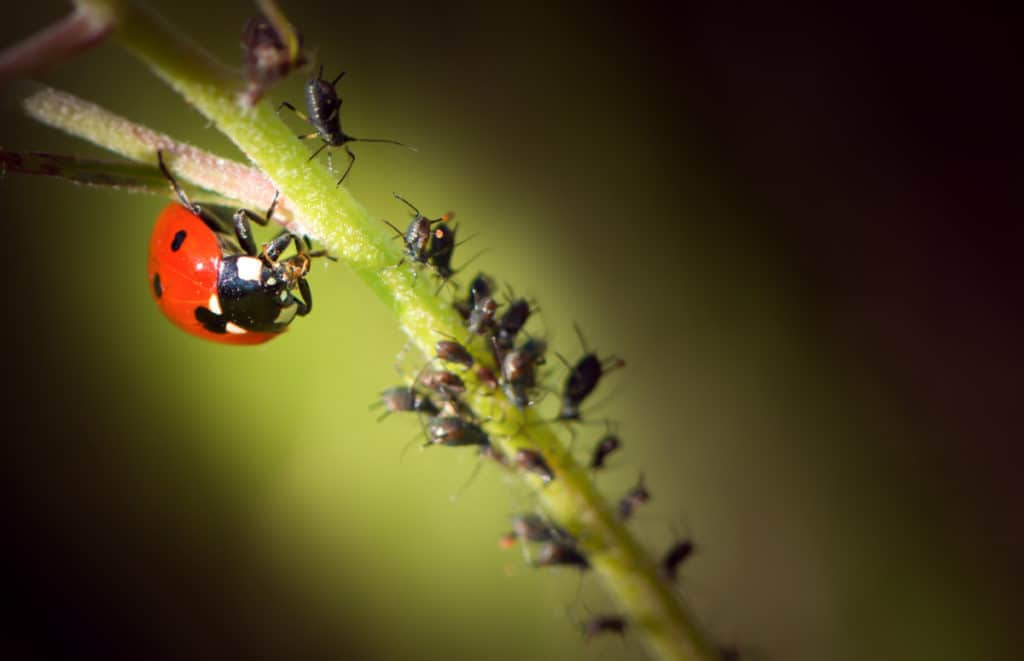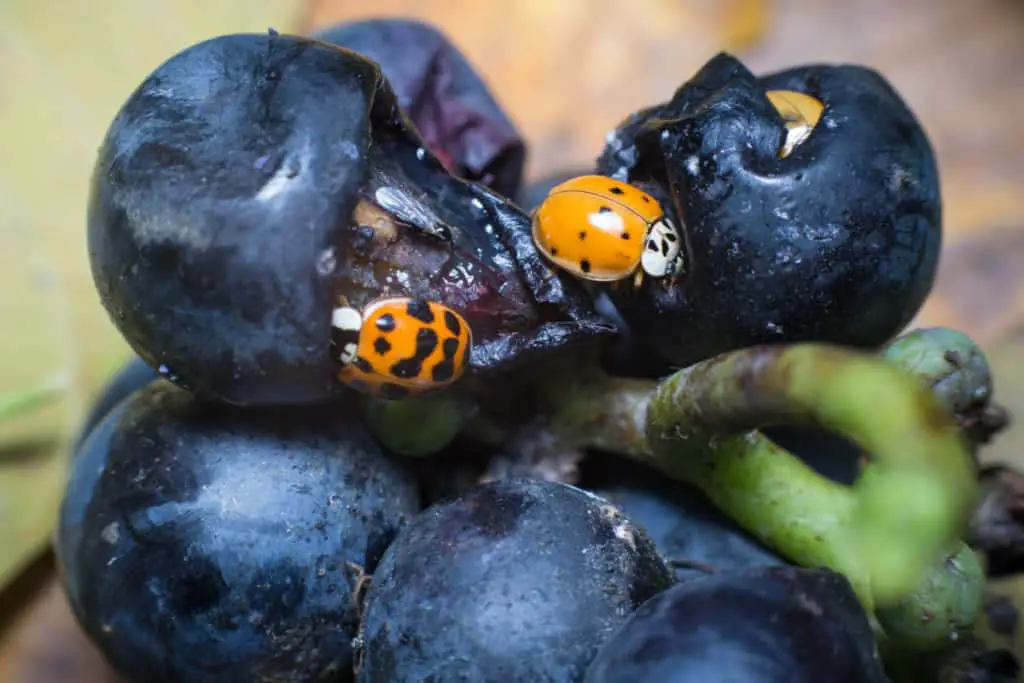It’s a well known fact that the much-loved critter can keep a check on the ‘crawling invaders” in your garden and prevent any pests from destroying and killing your vegetation.
But is the cutesy beetle a pest itself? Do they eat fruit?
Yes, ladybugs do eat fruit. Aphids are the primary food source for most species of ladybugs. However, they will eat low acid fruits like apples, pears, grapes, and blueberries. It is the sugar in the fruit that provide ladybugs with energy. For pet ladybugs rehydrating apricots or raisins is a good food option.
While this might come as a surprise and seem unusual, it is important to know that it is generally not their first food choice, but perhaps not that unusual.
So, why would a ladybug eat fruit when it is not their first meal choice?
Read on to find out.
Why Do Ladybugs Eat Fruit?
Ladybugs love the sweetness found inside the fruit. Some sources even advise on feeding your pet ladybugs with a honey-water mixture so they can get that sweetness they might love so much.
When it comes to diet, as well as living conditions and behavior each ladybug species differ,
Therefore, those taking on a task to keep a ladybug as a pet should first research and determine the type of the ladybug before deciding on the diet.
For example, looking at three common ladybug species found in Australia, the common spotted ladybird is a ferocious killer and can eat up to 2,500 aphids in its life.
The mealy bug ladybird is a fungus feeding species and has been said to have saved the California citrus industry in 1891.
Alternatively, the 28 spotted (also known as leaf-eating ladybirds) larvae and adults are vegetarian and feed on a range of plants.
What Types Of Fruit Do Ladybugs Prefer To Eat?
The species that do go for fruit as an option can feast on fruit types with low acid levels. You might spot them nibbling on apples, blackberries, blueberries, cherries, grapes, peaches, pears, nectarines, and raspberries.

It is also common to see ladybeetles snacking on strawberries as they are sweet, but also soft.
As mentioned above, ladybugs prefer fruits with a high sugar content.
Are Any Fruits Poisonous To Ladybugs?
Ladybugs can eat a wide variety of fruit, but experts recommend avoiding acidic plants.
It is believed that acids can break down food reserve and function as a natural pesticide, but there is no scientific evidence behind this.
One site suggests using citrus as an ingredient for the home-made repellent to rid pets of fleas.
The general opinion is that too much acid can be bad for ladybugs, and given their size, it is probably understandable.
Fruit high in acid includes items like lemons, limes, blue plums, pomegranates, grapefruit, and pineapple.
According to some sources, grapes are also high in acid with a pH of 2.9-3.20, however, most resources list this, as well as rehydrated raisins as safe to feed ladybugs due to the high sugar content contained in them.
This contradiction suggests that it is not the acidity level in citrus fruit that is bad for ladybugs, but perhaps another factor.
Can Ladybugs Live Off Fruit Alone?
Whether or not a ladybug can live on fruit alone is a good question and will depend on the species.
Most species have aphids as the main food source, a small pest that sucks juices from various plants in your garden and eventually kills them as a result.

In fact, with their ferocious appetites, they can eat up to 25 aphids in a single day, and depending on the species, from 2000 – 5000 in a lifetime.
Most ladybugs only live up to two years. Their diet can also include fruit flies, mites, white flies, small insects, and even fungi.
Must hydrate to survive, like most living things. But can they just drink water? We have dedicated a whole article to this topic it’s called, What do Ladybugs Drink?
There are approximately 5000 different ladybug species in the world, most of which are insectivores, so their main diet will never be only fruit.
The before-mentioned Australian species of ladybird – the 28 spotted ladybug – feasts on plant material and will go for almost anything in a vegetable garden, however, their focus is mainly on the leaves of the plants.
These include the leaves of tomatoes, pumpkins, squashes, and more. If you have a vegetarian ladybug, you will have to feed it the correct food sources and not only fruit.
Can You Feed Pet Ladybugs Fruit And What Is The Best To Feed Them?
The safest fruit to feed your ladybug is suggested to be re-hydrated apricots and strawberries. If you keep ladybugs as pets, you can even soak raisins in water to re-hydrate them before feeding them to your ladybug.
It is believed that they love the high sugar content. The same can be done with apricots.
Do You Need To Feed Pet Ladybugs Other Foods As Well?
All pets need proper care and a balanced diet, so feeding your ladybug a variety of different items will probably be best.
However, it is important to note that establishing the species you have is important – this will determine their primary diet.
Trying to feed a carnivorous ladybug plants or fruit might potentially lead to death if they decide not to consume anything for a prolonged period of time.
As mentioned before, ladybugs cannot live of a fruit only diet, similarly to how a human can not live of only chocolate.
Can Ladybugs Damage Fruit Crops Or Are They Not Considered A Pest?
Most native ladybug species will not damage fruit crops as they prefer feeding on aphids and soft-bodied insects.
However, an Asian species known as the Harlequin ladybird (Harmonia axyridis) is a known pest in many countries.
Identified by the ‘M’ or ‘W’ shape on their heads, they have spread to Europe and North America through an accidental introduction and biological control, which involves using species native from a certain country to control pests that originate from the country of origin.
The harlequin ladybug is an agricultural pest as they will gather in large numbers to feast on soft fruits.

Not only will this cause severe damage to crops, but can even taint entire wine harvests as they hide in grapes and are then processed with the fruit.
Once they run out of aphids and other insects, they go for fruit.
In New Zealand, where the species was first spotted in 2016, it is also reported to feed on damaged crops after they run out of its primary food source, which is aphids.
This species will also eat and destroy the eggs and larvae of native beneficial species, so can take over completely. Another source suggests that they will even kill the larvae of butterflies and moths.
The Wrap Up
Ladybugs are often seen as a benefit to gardens due to their aphid destroying characteristics, however, these little bugs tend to have a sweet tooth.
Many ladybug species will enjoy sweet non-acidic fruit as an additive to their diets, but cannot solely survive from them.
If you are keeping ladybugs as pets, it is a nice idea to supply them with some sweet fruit to snack on, just be sure to know about the species and what they can and cannot eat.
